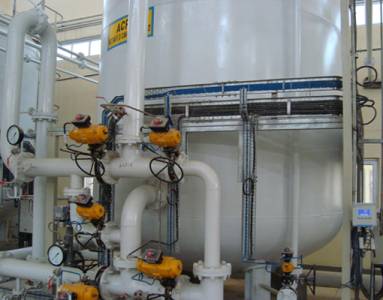Description
Demineralization: Achieving Pure Water Through Ion Exchange
Demineralization, also known as deionization (DI), is a crucial water purification process that removes dissolved mineral salts, such as calcium, magnesium, sodium, and chloride ions, from water. Unlike simple filtration, which only removes larger particles, demineralization targets the ionic contaminants at a molecular level, resulting in exceptionally pure water. This makes it ideal for numerous applications demanding high purity, from industrial processes to scientific research.
How Demineralization Works:
Demineralization primarily utilizes ion exchange resins, typically contained within a vessel or column. These resins are comprised of polymeric beads carrying either negatively charged (anionic) or positively charged (cationic) functional groups. As water passes through the resin bed:
- Cation exchange resins replace positively charged ions (cations) in the water with hydrogen ions (H+).
- Anion exchange resins replace negatively charged ions (anions) in the water with hydroxide ions (OH-).
The H+ and OH- ions then combine to form water (H₂O), leaving behind virtually no dissolved mineral ions. This process significantly reduces the total dissolved solids (TDS) content of the water, achieving a level of purity far exceeding that of conventional filtration methods.
Applications of Demineralization:
Demineralized water finds applications across diverse industries and fields, including:
- Power Generation: Protecting boilers and turbines from scaling and corrosion.
- Pharmaceutical Industry: Producing high-purity water for drug manufacturing and formulation.
- Electronics Manufacturing: Preventing contamination and short circuits in delicate electronic components.
- Chemical Processing: Ensuring the purity of reagents and products in chemical reactions.
- Laboratory Research: Providing ultra-pure water for scientific experiments and analysis.
- Food and Beverage Industry: Maintaining product quality and preventing mineral deposits in processing equipment.
- Semiconductor Manufacturing: Essential for wafer fabrication processes requiring exceptionally clean water.
Advantages of Demineralization:
- High Purity: Removes virtually all dissolved mineral ions, leading to exceptionally low TDS levels.
- Versatility: Applicable to a wide range of water sources and applications.
- Improved Equipment Performance & Lifespan: Protects equipment from scaling, corrosion, and fouling.
- Enhanced Product Quality: Ensures purity and consistency in various industrial processes.
- Reduced Maintenance: Minimizes downtime associated with equipment scaling and cleaning.
Limitations of Demineralization:
- Cost: Demineralization systems can be more expensive than other water purification methods.
- Resin Regeneration: The ion exchange resins require periodic regeneration or replacement to maintain their effectiveness.
- Non-removal of Non-ionic Contaminants: Demineralization primarily targets ionic contaminants and may not effectively remove non-ionic substances like organic molecules or bacteria. Further treatment may be required for complete purification.
Conclusion:
Demineralization provides a robust and effective solution for achieving ultra-pure water, crucial for a vast array of applications where high purity is paramount. Understanding its mechanism, advantages, and limitations allows for informed decision-making regarding its implementation in specific contexts. Choosing the right demineralization system depends heavily on the required purity level, water flow rate, and specific contaminants present. Consult with water treatment experts to determine the most suitable system for your needs.
